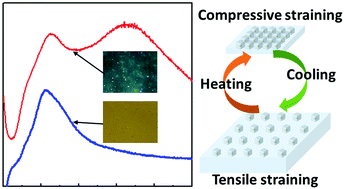Active strain engineering of soft plasmene nanosheets by thermoresponsive hydrogels†
Abstract
Epitaxy has been demonstrated to be a powerful technology to precisely engineer strains at the atomic level to modulate semiconductor device properties. However, it is not suitable for strain engineering in nanoscale lattice structures, such as two-dimensional ligand-based plasmonic nanoparticle superlattices (termed as soft plasmene nanosheets). Although unidirectional tensile strain has been applied to soft plasmene nanosheets, strain engineering was not omnidirectional across the entire lattice structures. Here, we report on omnidirectional strain engineering of soft plasmene nanosheets by utilizing thermoresponsive hydrogels in conjunction with temperature programming. Pristine plasmene nanosheets were naturally under compressive strain states upon formation, which could be transferred onto poly(N-isopropylacrylamide) hydrogel. In the model gold@silver nanocube plasmene system, the constituent building blocks could be switched between non-coupling and strongly-coupling states simply by modulating the temperature, corresponding to the highest tensile and compressive strain conditions, respectively. This led to a significantly broad plasmonic spectral shift of over 200 nm. Consequently, it caused drastically different surface enhanced Raman scattering (SERS) enhancements of model Raman dyes, which are reversibly switchable simply by heating and cooling. Our temperature-enabled omnidirectional strain engineering is extendable to other plasmonic nanosheets, indicating its generality and versatility.



 Please wait while we load your content...
Please wait while we load your content...